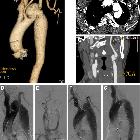carotid artery pseudoaneurysm



Carotid artery pseudoaneurysms can refer to pseudoaneurysms involving any segment of the carotid arteries.
Pathology
As with pseudoaneurysms elsewhere, these lack all three layers of the arterial wall (intima, media and adventitia).
Pseudoaneurysm development can occur within hours to several years after initial arterial injury although normally presenting within 5 years .
Causes
Pseudoaneurysms can arise from varying causes which include
- trauma
- penetrating trauma
- blunt trauma
- arterial dissection
- vasculitides, e.g. Behcet disease
- infection, e.g. mycotic carotid arterial pseudoaneurysm
- as an iatrogenic complication following procedures
- following carotid endarterectomy: uncommon complication
- following transsphenoidal surgery: rare
- surgical neck dissections: rare
- misplaced central venous lines: rare
Radiographic features
Imaging evaluation is often with Doppler ultrasound and CT angiography.
Treatment and prognosis
Management options can range from traditional surgical repair to endovascular repair (stent placement - combined stent placement and coil embolization ). Mortality rates of up to 30% have been reported in the case of external carotid arterial pseudoaneurysms. In certain situations, more conservative approaches are taken (i.e observation )
Differential diagnosis
- true aneurysm of carotid artery
Siehe auch:
- Aneurysma spurium
- Vaskulitis
- Morbus Behçet
- Aneurysma der Arteria carotis interna
- Aneurysma Arteria carotis
und weiter:

 Assoziationen und Differentialdiagnosen zu Pseudoaneurysma der Arteria carotis:
Assoziationen und Differentialdiagnosen zu Pseudoaneurysma der Arteria carotis:




